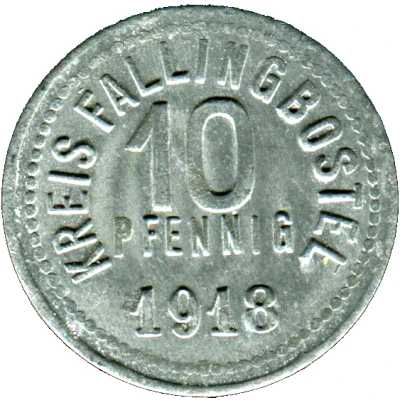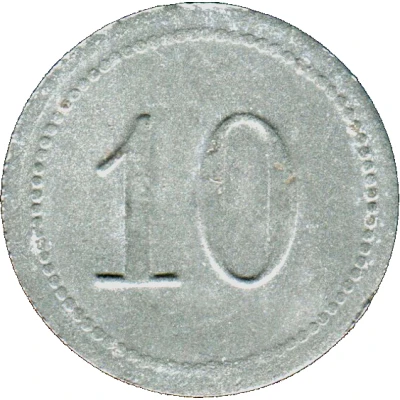


© derfnumismatics
10 Pfennigs - Fallingbostel
1918 year| Iron | 3.46 g | 23.5 mm |
| Issuer | District of Fallingbostel (Prussian province of Hanover) |
|---|---|
| Type | Standard circulation coin |
| Year | 1918 |
| Value | 10 Pfennigs (10 Pfennige) (0.10) |
| Currency | Mark (1914-1924) |
| Composition | Iron |
| Weight | 3.46 g |
| Diameter | 23.5 mm |
| Thickness | 1.30 mm |
| Shape | Round |
| Technique | Milled |
| Orientation | Medal alignment ↑↑ |
| Demonetized | Yes |
| Updated | 2024-10-04 |
| Numista | N#64954 |
|---|---|
| Rarity index | 85% |
Reverse
Pearl rim surrounding denomination centered
Script: Latin
Lettering: 10
Edge
Plain
Comment
Issuing authority: [Kreis, Hannover]Die rotation variations exist potentially leading to coin rotation. Exact coin rotation is questionable and is possibly counterfeit
At 127.4a, a 7 is always recognizable under the 8 in 1918
Interesting fact
The 10 Pfennigs - Fallingbostel 1918 coin is interesting because it was produced during a time of economic turmoil in Germany, known as the "Inflationary Period" (1914-1923), when the value of the German mark plummeted, and the prices of goods and services skyrocketed. As a result, the government was forced to produce smaller denomination coins, like the 10 Pfennigs, to keep up with the increasing demand for small change. Despite being made of iron, which was a cheaper metal than the traditional copper or silver, the coin still had a relatively high face value, indicating the severity of the economic crisis.